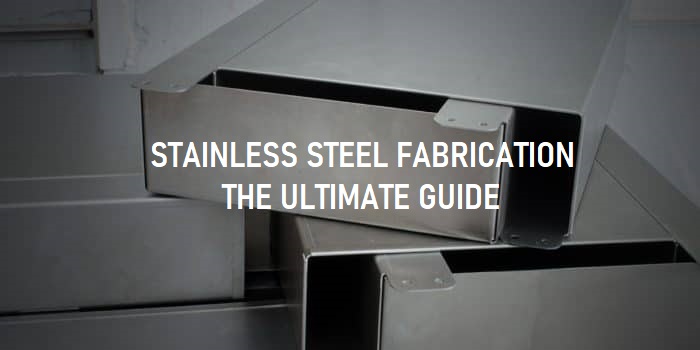
If you are a stainless steel fabricator or simply seeking valuable information and insights on stainless steel fabrication, then you have just landed on the right site with loads of resources!
In this guide, we explore the main types of stainless steel or inox steel fabrication materials, the advantages, the techniques used, valuable tips on choosing a fabricator, and much more!
Let’s begin to explore!
1. Common Types of Stainless Steel Fabrication

Here are some of the most common fabrications you can consider for your wide range of industry projects:
1.1 Stainless Steel Sheet Metal Fabrication
This type of fabrication requires a stainless steel metal sheet as your production material
You can customize your stainless steel sheet metal fabrication for products such as:
- Stainless Steel Metal boxes or enclosures
- Stainless Steel Trims
- Stainless Steel Doors
Some of the most common stainless steel types and grades you can choose for your stainless steel sheet metal fabrication include:
- Stainless Steel Sheet Metal Grade 304
- Stainless Steel Sheet Metal Grade 316
- Steel Sheet Metal Grade 410
More Resources:
1.2 Stainless Steel Pipe Fabrication
In this fabrication, fabricators use specialized equipment to manipulate stainless steel tubes to suit the required application design.
It is versatile and allows for the fabrication of pipes of different sizes and shapes based on your project’s needs.
Some of the common and most suitable materials for your stainless steel pipe fabrication include:
- Stainless Steel T304 and T316
- Martensitic – Grade: 410
- Ferritic – grade 430
1.3 Stainless Steel Plate Fabrication:
In this type of Inox fabrication, you manipulate your selected stainless steel plate material to achieve the desired component shape and size.
Therefore, the fabrication process will involve mainly cutting, forming, and welding using specialized tools.
1.4 Stainless Steel Structural Fabrication
Structural fabrication is mainly adopted when you are working on structural components and especially those used in the construction industry.
The main fabrication process involves cutting, bending, welding, and assembly
To get excellent results, your stainless steel fabricator must be equipped with specialized tools such as plasma cutters, Computer Numerical Control (CNC) machines, and plasma cutters among others
1.5 Stainless Steel Custom Fabrication
Sometimes your project requirement may be unique, calling for the production of custom-made stainless steel parts or components.
For quality stainless steel custom fabrication, you must engage the services of a professional fabricator with the right tools, technology, and experience.
More Resources:
2. 14 Advantages of Stainless Steel Fabrication
Here are some of the main advantages you will reap by adopting inox fabrication for your metal parts and application components’ production:
1. Corrosion-resistance
The top advantage of inox steel fabrication is its high corrosion resistance.
This ensures that your fabricated products remain resistant to rust when exposed to harsh conditions like moisture, acidic, alkaline, or chlorinated environments.
Therefore, you are assured that your fabricated stainless steel part will maintain both its integrity and physical appearance.
2. Safe and Non-Toxic
The corrosion-resistant steel fabrication process produces non-toxic parts. Your fabricated products will also be resistant to mold and are super easy to clean. Its safety and non-toxicity make its products useful in both the food and medical sectors.
Again, the materials used for stainless steel fabrications are non-reactive. This ensures that your final products remain safe
Stainless steel fabrication also ensures that instances of accidents occurring at your project sites are limited.
This is because components can be fabricated in special workshops before being taken to their application locations.
3. Enhanced Metal Strength
Further, the inox steel fabrication process ensures that your metal product’s strength-to-weight ratio is significantly enhanced.
And so if your fabricated part is subjected to heavy loads even in harsh conditions, its structural integrity is not compromised.
4. Promotes Good Hygiene
Corrosion-resistant Steel fabrication products are non-porous making them perfect for sterilization and hygiene applications.
Because your fabricated stainless steel parts have super smooth surfaces that are easy to clean, they will not encourage the development of bacteria making them free from harmful contaminants.
And so where a high level of cleanliness is desired such as in the kitchen, hospital, or healthcare facility, choosing fabricated stainless steel items is your highway way to ultimate hygiene!
Other relevant resources:
5. Resistant to High Temperatures and Pressure
Stainless steel fabrication processes are resistant to both high temperatures and pressure. Therefore, your products’ integrity will not be easily compromised during their applications.
6. Guarantees Durability
With corrosion-resistant steel fabrication, your final product will be durable because of its ability to withstand tear and wear.
And so the durability of your stainless steel fabrication products such as fuel tanks or stainless steel sinks is guaranteed.
7. Versatility
With stainless Steel fabrications, you are not limited by options when manipulating the material to achieve the desired shapes or sizes to suit your application requirements.
So, whether you are working on an architectural component or creating a high-precision engineering part, stainless steel metal fabrication provides you with much-needed flexibility in product creation.
8. Environmental Friendly
Again, Inox steel fabrication has a low impact on the environment
This is because your fabrication products and materials will be 100% recyclable with no deterioration in their initial properties.
9. Aesthetic Appeal
Another advantage of Inox steel fabrication is the beauty that its sleek and modern look radiates!
Whether you go for stainless steel trim for your interior decor, stainless steel railings, or tubes for your architectural structure, there is a wide range of surface finishes your fabricator can provide for the ultimate aesthetic appeal.
Some stainless steel fabricators also offer stainless steel polishing services to ensure that your fabricated stainless steel products are extremely appealing and of premium standard.
10. User-friendly
Inox steel fabrication is also user-friendly and allows you to explore endless customization possibilities!
11. Allows for High Accuracy Level
With stainless steel as your fabrication material, you can achieve a high level of accuracy to create your desired final product component.
12. Less Costly
Compared to other fabrication metals and alloys, Inox steel fabrication is cheaper and, therefore, worth considering.
13. Low-Maintenance Costs
Further, corrosion-resistant steel fabrication does not require special surface treatment or cleaning. Its fabricated parts are also more flexible and durable. Therefore, you will incur very low maintenance costs
14. Impressive Resistance to Fire
Stainless steel provides excellent resistance to fire making your fabrication processes ideal for fire-safety components such as fire-rated enclosures.
3. 9 Industry & Home Applications of Stainless Steel Fabrication
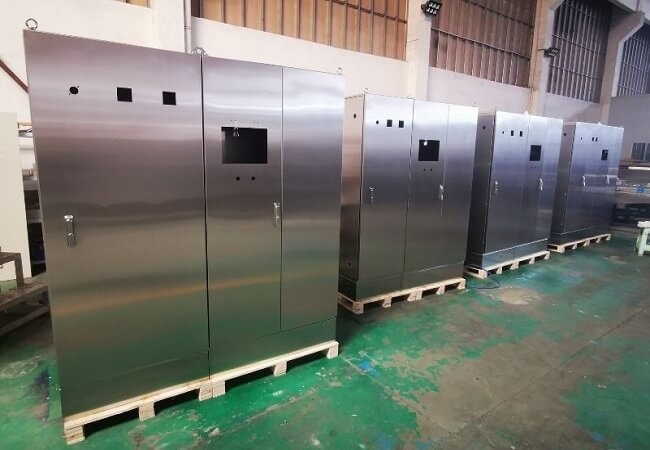
Due to the unique properties that stainless steel manifests such as high strength and excellent corrosion resistance, it is no wonder that its fabrication products have found application in several industries.
Let’s explore some of the main application areas you will come across.
3.01 Transportation Industry
You will find corrosion-resistant steel fabrication products in the automotive, aerospace, railway, and marine transport sectors.
In the automotive industry, for instance, inox steel fabrication is used to produce exhaust systems, hoods, and vehicle bodies.
In the sea transportation industry, marine-grade stainless steel is used to fabricate deck grills, cargo tanks, and handrails.
Stainless steel sheet metal fabrication is also used to produce application parts for the aerospace industry.
More Resources:
3.02 Manufacturing Industry
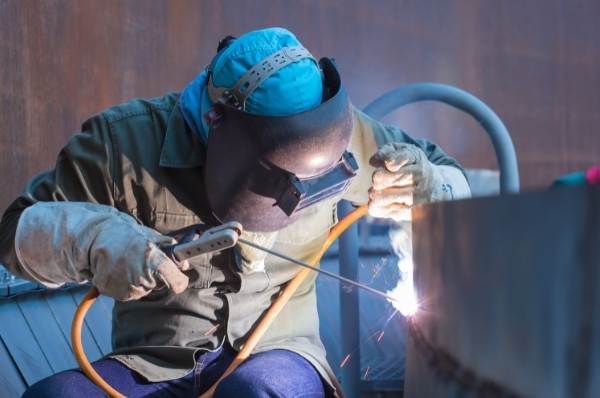
You will also find the use of stainless fabrication common in the manufacturing industry.
For instance, stainless steel processing tanks and stainless steel augers used in several manufacturing facilities are made through fabrication.
More Resources:
3.03 Home Applications



Modern homes boast a wide range of stainless steel fabrication appliances and structures.
Some of the common stainless steel fabricated items and structures you will get in homes include:
Stainless steel cutlery and utensils, electric appliances such as ovens and refrigerator parts, and stainless steel railings among others.
More Resources:
3.04 Construction Industry
Stainless steel fabrication is used in the production of construction structures.
This is because of the metal’s corrosion resistance, strength, durability, and aesthetic appeal.
Some of the fabricated stainless steel construction products you will find include stainless steel stairs, handrails, and aesthetic components.
More Resources:
3.05 Energy Sector – Oil, Gas, & Power Generation
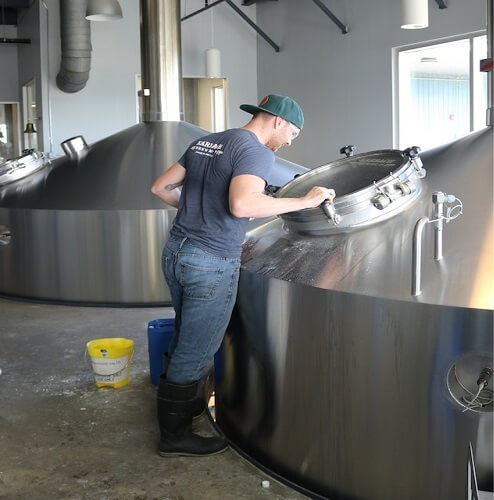
This is yet another sector where you will find common applications of Inox steel fabrication.
The main properties of stainless steel that make it a perfect fabrication material for this sector application include corrosion resistance, strength, and tolerance to high-temperature.
And so some of the application areas within the energy sector are in the production of storage vessels, containment containers, and heat exchangers among other areas.
3.06 Marine Sector
If you are from the marine industry, you will find extensive applications of stainless steel fabrication.
This is mainly because stainless steel, apart from its superior tensile strength, provides excellent corrosion resistance, and therefore, guarantees durability.
And so you will find stainless steel fabrications being adopted in the building and repair of boats, ships, and other seawater vessels.
Other marine products such as engine propellers, or marine railings, are produced by stainless steel fabrication techniques.
3.07 Food Processing Industry
During stainless steel fabrication processes, components remain corrosion-resistant.
This makes it the perfect process for the production of items such as food storage tanks, sinks, and screw conveyors among other products.
3.08 Medical Sector
If you are within the medical sector, some of the stainless steel fabrication products you will use or require include surgical tools, orthopedic braces, bed frames, shelves, and storage cabinets among others.
Stainless steel’s hygienic and safe properties make it a perfect fabrication material for medical and health sector applications.
More Resources:
3.9 Custom-made Stainless Steel Applications

Stainless steel fabrication is very versatile. You can produce a wide range of custom-made products such as stainless steel electrical enclosures, mailboxes, screw conveyors, hoppers, and custom railings.
More Resources:
- Custom Stainless Steel Sheet
- Custom Metal Letters
- Sheet Metal Box Fabrication
- Sheet Metal Mailbox
- Sheet Metal Handle
- Sheet Metal Picture Frame
- Custom Metal Book Stand
4. 15 Techniques & Processes in Stainless Steel Fabrication – Exploring All The Possibilities

The techniques or processes used in Inox steel fabrication are numerous. Their applications and stages are, however, determined by your specific project requirements.
Below are some of the techniques and processes that professional stainless steel fabricators use when working on your wide range of projects:
4.01 Work Hardening and Heat Treatment
The work-hardening, also called the cold-working technique, aims at strengthening your fabricated stainless steel material by changing its internal structures.
This is achieved by subjecting your material to different deformation processes such as rolling, hammering, bending, stamping, or twisting.
It is important to note that work-hardening only works on austenitic grades of stainless steel
If, however, your fabrication process is on Martensitic stainless steel, then a controlled heat treatment technique can be adopted for certain components.
4.02 Cutting
KDM Electrical Enclosure Laser Cutting, Electrical Enclosure Stainless Steel Panel
This is one of the most common fabrication techniques where you reduce the size of your stainless steel material to achieve the right size or shape for your component production.
some of the cutting methods you can adopt include:
Grinding, saw-cutting, laser cutting, plasma cutting, punching, filing, drilling, and water jet cutting among others.
More Resources:
4.03 Forming
This is a fabrication technique where heat is applied to your stainless steel material to allow for easy deformation to suit the desired shape.
Forming process may be achieved through pressing, press-forming, and spinning.
To be professionally done, your stainless steel fabricator must be fully equipped with specialized forming tools and machines.
4.04 Bending

This technique involves using special tools to bend your stainless steel material into the desired shape or size. No pre-heat treatment is needed in this process.
Your choice of bending tools will be determined by the nature and size of your stainless steel fabrication material.
Some of the tools you require include but are not limited to rolling machines, Bending rolls, press brakes, and the right trapping tools.
4.05 Folding:
This is a stainless steel fabrication technique where you use a powerful machine tool to fold significant metal components into the required shapes.
The technology is commonly used when fabricating stainless steel construction structures such as joists and beams among others.
4.06 Welding

Welding is yet another stainless steel fabrication technique where you use heat to join metal components.
You achieve this by either a gas flame or using welding rods.
Some of the common welding technologies and methods you require for this process includeTungsten Inert Gas(TIG) welding, Metal Inert Gas(MIG) welding, and spot welding.
More Resources:
4.07 Soldering
Soldering is a stainless steel fabrication technique where different parts of your fabricated component are joined using a filler metal commonly known as a solder.
This technique comes in handy for fabrications of home products and appliances such as stainless steel furniture, stainless steel racks, and stools among others.
Depending on your type of project, you can adopt tin-lead soldering also known as soft soldering or tin-silver also called hard soldering
Where high strength and ductility are required, you are better off choosing a tin-silver soldering technique.
4.08 Blanking
Blanking is a stainless steel fabrication technique where you cut your metal into desired shapes. The most commonly used tool for this fabrication process is a stamping press machine.
If your project involved the fabrication of stainless steel components such as gaskets, brackets, or intricate components, then blanking may be your ideal fabrication technique.
Sheet Metal Blanking Process no 0059
More Resources:
- Sheet Metal Blanking Guide
4.09 Assembly of Parts
Parts assembly is adopted when you want to join separate stainless steel components to form a single complete component.
Parts assembly is commonly in the production of fabricated stainless steel furniture, or tools with multiple sections.
More Resources:
4.10. Deep Drawing
Deep drawing is yet another stainless steel fabrication process that you use to produce complex components.
It involves stretching your stainless steel sheet metal into a desirable shape using a die and a punch.
This process is applicable when you are fabricating products such as stainless steel boxes, cups, or other unique shapes.
More Resources:
4.11 Machining

Stainless steel machining is a fabrication technique or process that you adopt to get the desired final product size or shape.
This is critical when your project demands high precision such as in the fabrication of medical industry products, and engine parts such as transmission components
And so machining involves a controlled or systematic cutting or removal of your component’s parts using specialized machining tools
One of the most outstanding properties of stainless steel that makes machining a suitable fabrication technique is its superior strength-to-weight ratio
As a stainless steel fabricator, there are special machining tools you must invest in for your fabrication projects.
You require suitable machining tools for drilling, milling, grinding, turning, and boring.
Depending on your project needs, there are highly-specialize machining techniques suitable for a wide range of stainless steel fabrication.
Some of the techniques you must consider include CNC machining, Swiss screw machining, and Electrical Discharge Machining(EDM)
More Resources:
4.12 Punching
Punching is a stainless steel fabrication process where you create the desired holes in your metal sheet or plate. The technique uses a press punch which consists of a die and a punch.
For simple or basic fabrication tasks, you can use a hand-held metal hole punch. However, for large, complex, and high-precision projects, you need a punch-processing machine
More Resources:
4.13 Stamping
This is a stainless steel stamping process used to create simple or complex components’ shapes and sizes with the help of a die.
You will find the technique commonly used in the fabrication of high-precision engine parts and a wide range of medical components.
More Resources:
4.14 Surface Finishing

The stainless steel surface finishing or surface treatment process aims at improving the quality, durability, and aesthetic appeal of your fabrication component.
Depending on your fabrication requirements, some of the stainless steel surface treatments you can choose from include polishing, pinning, and buffing among others.
More Resources:
4.15 Stainless Steel Etching
This process is used when your stainless steel fabrication involves creating either an artwork, symbol, or brand name on the surface of your components.
If your project requires deeper markings then you may opt for an engraving process.
More Resources:
5. Common Stainless Steel Grades Used In Fabrication
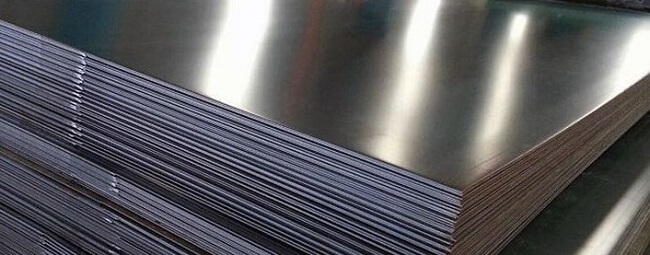
Your selection of stainless steel grades depends on your project requirements.
Here are the most common stainless steel types and grades to consider for your various fabrication projects:
5.1 Ferritic Stainless Steel – 430 Grade & 409 Grade
Ferritic Stainless steel grade 430 is a commonly used fabrication material. The grade is corrosion-resistant, ductile, and has excellent formability.
Because of its attractive appearance, you can consider it when working on decorative components.
However, when your fabrication project involves welding and demands high corrosion resistance, then 409 Grade is the best option.
5.2 Austenitic Stainless Steel – 316 Grade
Austenitic grade 316 is also a common material for your stainless steel fabrication. It is soft and easy to machine making it an ideal material for the production of a wide range of stainless steel products.
If your fabrication project involves the production of stainless steel medical components, food processing products, or chemical production tanks among others, then this is a perfect material for you.
5.3 Austenitic Stainless Steel – 304 Grade
Another popular stainless steel material to choose for your project is Austenitic Grade 304. It is easy to weld and provides excellent ductility and formability.
This stainless steel grade is ideal when you are in the production of components such as food processing equipment, kitchenware, and kitchen sinks among others.
5.4 Martensitic Stainless Steels – 410, 420, & 440C Grades
These grades are known for their high corrosion resistance and wear resistance. Some of the products they are suited for are kitchenware, knives, and surgical instruments.
The grade 440C stainless steel boasts extreme corrosion resistance and suits suitable if you are in aerospace parts fabrication projects.
6. 12 Mistakes To Avoid During Stainless Steel Fabrication
To ensure that your stainless steel fabrication products are of top quality and fulfill their application requirements, here are the common mistakes you must avoid:
6.01 Failing To Follow Safety Guidelines
The common expression of “safety first” should apply during your stainless steel fabrication processes.
You must be in the right safety gear such as a protective hat, hand gloves, safety boots, and protective eyeglasses.
You should also keep your work environment safe from potential hazards to avoid risks of fatal accidents or damages. All safety policies and guidelines should be followed accordingly.
6.02 Using Excessive Heat During Welding or Cutting
You must control the heat and use the right welding techniques and machine when cutting or welding your stainless steel materials.
Excessive heat during the cutting or welding process will compromise the chromium in your stainless steel and affect its long-term corrosion resistance
6.03 Exposing Material to Contaminants
When your fabrication of stainless steel material is exposed to certain contaminants, its resistance to corrosion and rust can be easily compromised.
So, keep your material free from water or moisture, dirt, oil, and other contaminants that can trigger oxidation during your fabrication processes.
6.04 Failing to Clean or Improper Cleaning
Failing to clean your fabrication processing areas, using the wrong cleaning detergents, or adopting the wrong cleaning techniques will expose your components to harmful contaminants.
6.05 Choosing The Wrong Fabrication Material
Stainless steel comes in different grades and fabrication forms. It is, therefore, important that your chosen fabrication material is suitable for your specific project requirements.
6.06 Unrealistic Scheduling
If you create a production schedule, allow for possible delays.
Sticking to your schedule or making unrealistic schedules will only ruin the quality of your fabrication components. This will ultimately dent your reputation as a stainless steel fabricator.
6.07 Failing to Follow Specifications
Creating shortcuts by not following the provided fabrication specifications will result in the production of either low-quality or unusable products.
Adopt the right fabrication techniques or processes based on your project requirements.
6.08 Unrealistic Product Design
You must ensure that your product design is achievable through your fabrication processes.
Trying to work on unrealistic specifications can easily result in a failed project or unnecessary loss of resources.
6.09 Not Being Flexible With Fabrication Techniques
Different stainless steel materials require that you adopt different fabrication techniques based on the nature of the design you are working on.
Therefore, flexibility in the choice of suitable techniques and tools during the entire fabrication process is critical.
6.10 Scratches and Physical Damages
Scratches and physical dents on your stainless steel are prone to affect the quality of your final products.
Avoid using incorrect or abrasive tools that would damage or create unsightly scratches on your material.
Also, make sure that you use only the recommended friction-reduction lubricants accordingly during the fabrication process.
6.11 Ignoring Quality Control
You must periodically inspect your stainless steel fabrication processes to achieve the desired quality standards.
Quality control ought to begin at the start of your fabrication process. Prior inspection is to ensure that your material is free from physical defects.
6.12. Taking Incorrect Measurements
Taking measurements is critical when fabricating stainless steel. Remember to allow for the necessary tolerances based on your type of component.
To ensure that you don’t make mistakes and not come up with a wrong product, it is recommended that you take each measurement twice.
7. 12 Factors You Should Consider When Choosing Your Stainless Steel Fabricator
Taking time to search for a suitable stainless steel fabricator is important if you have to get high-quality products and value for money.
Here are some of the factors you must consider when searching for a stainless steel fabrication company:
7.01 Your Fabrication Design
You need to have a fabrication design that you should share with your fabricator. The fabricator will have to provide feedback on whether your design is achievable or recommend improvements.
7.02 Stainless Steel Fabrication Experience
Stainless steel fabrication calls for skill and experience. It is for this reason that you must only consider a fabrication company that boasts a highly experienced stainless steel fabrication team.
7.03 Type of Design Material
If you have chosen a specific material or are not sure of which stainless steel material to use for your component fabrication, share this with the fabricator.
A professional fabricator should have a better understanding of different materials and advise on the most suitable material for your desired component.
7.04Delivery or Manufacturing Time
Ensure that the stainless steel fabricator you partner with is capable of meeting your project deadlines.
The fabricator should also be capable of facilitating prompt delivery of your finished products.
7.05 Fabrication Technology
By considering the fabrication technology that your fabricator uses, you will determine how best they are suitable to successfully handle your stainless steel fabrication project.
Before you engage them, make sure they have the right tools and equipment to complete your project timely and to your desired standard.
7.06 Workforce Capacity
You should also consider both the size and the capacity of a fabricator’s workforce.
This is because these are indicators of whether a fabricator can deliver your project timely and to your desired standard.
7.07 Financial Stability
You certainly can’t risk engaging the services of a fabricator dealing with financial challenges as this will negatively impact their service delivery.
Finding information on a fabricator’s financial capacity is, therefore important.
A suitable and financially stable fabricator ought to provide you with a quote that is within your budget range and a reasonable payment schedule.
7.08 Customer Service & Customer Support
Find out your stainless steel fabricator has excellent customer service to respond to your inquiries throughout the fabrication period.
For certain projects, your fabricator must also have a customer support team to address any issues that might arise after the fabrication process.
7.09 Work Portfolio & Customer Reviews
Before choosing your stainless steel fabricator, do online research on what their past customers think about their services. Check their reviews.
You can also ask the fabricating company to provide you with a portfolio of their past projects.
7.10 Location
The location of your fabricator and the region they serve is critical because this may determine how much you spend on shipment.
It is important to note that location is only important if the fabricator also has the necessary facilities and experience that your stainless fabrication process needs
7. 11 Quality Control Measures

Quality control at every stage of metal fabrication is critical if you have to get high-quality products.
And so, you ought to find out if your fabricator or fabricating company has quality control systems within their entire fabrication processes. Inquire about the certifications they have
7.12 Competitiveness Pricing
If you have a major fabrication project, it is prudent that you seek quotations from different potential fabricators.
You then need to study all the prices and only consider those offering the most competitive and comprehensive pricing.
8. Conclusion
Stainless steel fabrication calls for in-depth knowledge of the various types of fabrications and materials suitable for different projects.
You need to be aware of the various fabrication techniques and processes as well as the types of machinery tools your project needs.
To ensure you produce high-quality products for enhanced customer experience there are various fabrication mistakes you must endeavor to avoid.
Finally, if you have a project and searching for a suitable stainless steel fabricator, there are factors you ought to keenly consider to ensure your project’s success.
More resources:
Step-by-step Stainless Steel Stamping Process – Source: KDM




